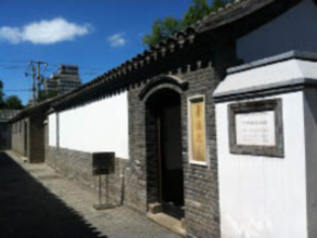Lu Xun at Home
Given the prominence of his family, the paucity of objects such as furniture and art works left behind is arresting and poignant – but that’s at the heart of the story. In the museum is a small patchwork jacket Zhou Zhangshou (Lu Xun was his pen name) wore as a child (as it turns out, it’s a reproduction); in his former home are a few faded items of his mother’s sewing; in the schoolroom is the desk he defaced with a carving of the character zao, meaning early. With their polished furniture, the rooms of the Native Place buildings have the appearance of comfort and well-being; however, these items are simply placeholders, not the family’s original belongings.
The Zhou family suffered a series of misfortunes that marred Lu Xun’s childhood. His grandfather, a member of the Qing Dynasty Imperial Academy, was imprisoned for attempting to bribe an imperial examiner. His father was unable to find work and descended into alcohol and later chronic illness. Much later, in writings about his Shaoxing childhood Lu Xun recalled his dreary relay between pawnshop and pharmacy to trade his mother’s jewelry, their clothes, furniture and trinkets to pay for ever more fantastical medicines for his father: sugar cane that had survived three years of frost, chaste crickets, worn leather of broken-down drums. None of these could save him – he died at 35, and the teenaged Lu Xun was never to forget the deprivations and humiliations of those years.
Lu Xun’s memories of Shaoxing remained conflicted – he was nostalgic for childhood pleasures and the richness of South China literary culture, but in both fictions and autobiographical essays, he was deeply critical of the inhumanity he first encountered there.
Yet, the atmosphere now at Shaoxing is almost unfailingly celebratory, and evocative of the unclouded days when Lu Xun was known as “lamb’s tail” for his liveliness. The Native Place buildings display the elegant monochromes of a traditional South China canal town, reflected in the water that is so much a presence in this Yangtze Delta region. The pawnshop is an after-thought, far overshadowed by the neatly tended Hundred Plants Garden where Lu Xun foraged as a small boy for wild raspberries, trapped crickets and jumped clear of the noxious spray of tormented stink bugs. In a side courtyard a visitor can sip warm rice wine spiced with ginger and enjoy the sight of hibiscus sprawling rampantly against a garden wall, as the Zhou family must once have done before they had to sell their possessions and, finally, their home.
Under the Beijing Sky
Houses aren’t in themselves melancholy – we read that emotion into empty spaces. Or, if we are fanciful, detect the residue of past disappointments. What is now the Lu Xun house museum near Fuchengmen in Beijing’s Xicheng District was his residence only from May 1924 to August 1926, the period at the end of his years in the city.
 |
|
Lu Xun’s Fuchengmen residence in Beijing where he lived from May 1924 to August 1926. |
Earlier, in 1919 he had purchased a large compound in Badaowan, in the same district, where he lived with his extended family: his mother, wife, two brothers and their wives and children. He was particularly close to his middle brother, Zhou Zuoren, with whom he had studied in Tokyo and worked on translation projects. However, following a still unexplained rift between the brothers, Lu Xun moved into the Fuchengmen complex, where he lived with his mother and his wife, Zhu An.
His marriage was arranged, and was unsuccessful. The configuration of his new home reflected the isolation of these years. His mother and wife’s rooms are on the north side of a courtyard. Behind is a room Lu Xun used as his own bedroom and study, known affectionately as “the tiger’s tail.” It’s furnished simply and overlooks a small, secluded rear courtyard.
These were the years of the introspective, often melancholy prose poems collected in Wild Grass. On the New Year’s Day of 1925, he wrote: “My heart is extraordinarily lonely. But my heart is very tranquil, void of love and hate, joy and sadness, color and sound.” Alone in his study at night he looked up at the Beijing sky and found it strange and high. He dreamed he was running along a mountain of ice. He dreamed he was lying in a wilderness beside hell. He dreamed he was dead. His short stories of the period, published in the 1926 collection Wandering, so often dwell on the misunderstandings and unhappiness of marriage.
- Ji Dachun: Imagine It, Paint It
- Dang Zhongxin: Breathing New Life into an Antique Opera
- Confucius: Education Should Be Accessible to Everyone – Confucius Institute Düsseldorf Builds a Bridge to Chinese Language and Culture
- Decipher the Overseas Success of “Decoded”
- If You Are the One: Love at First Sight
